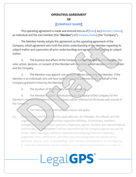What to Do When You Take on a Silent Partner
Your small business is growing, but you’re hitting a wall—inventory costs are climbing, and you need cash to scale. A friend offers to invest $50,000...
5 min read
LegalGPS : Oct. 21, 2025
You and your business partner built a thriving startup together, but over coffee, they drop a bombshell: they want out to pursue a new venture. Their exit could destabilize your finances, disrupt operations, or spark legal battles over assets and clients. A business partner’s departure is a high-stakes moment that threatens your company’s future if mishandled, but with the right approach, you can manage it smoothly and come out stronger.


Legal GPS Pro
Protect your business with our complete legal subscription service, designed by top startup attorneys.
This guide walks you through how to handle a business partner’s exit, offering a clear, actionable plan to protect your business and plan for what’s next. From reviewing agreements to updating terms, we’ll cover five key steps, packed with real-world examples and practical “Pro Tips” to ensure a fair and legal process. Whether you’re a startup founder, small business owner, or freelancer with a co-owner, let’s navigate this transition with confidence.
Your partnership agreement is the blueprint for handling an exit, so start by digging into its terms to understand your rights and obligations.
Look for exit clauses: Does it specify a buyout process, like “departing partner’s share valued at 2x annual profits”? Check for notice periods (e.g., “60 days’ written notice”) or valuation methods (e.g., third-party appraisal). Review obligations, such as non-compete clauses preventing the partner from starting a rival business or confidentiality terms protecting client data. If the partner breached the agreement, like failing to meet sales targets, it could justify a discounted buyout.
Document the relevant clauses and any disputes in a Google Docs file. If you lack a written agreement, state laws govern exits, often requiring a fair split, but a lawyer’s guidance is critical. The Small Business Administration offers partnership guidance to clarify terms.
Sarah’s co-founder wanted to leave their tech startup. The partnership agreement required a buyout at “fair market value, determined by an independent appraiser,” with a 90-day notice. Sarah confirmed no breaches and noted the non-compete clause, ensuring the partner couldn’t poach clients. Her review gave her a clear path to negotiate.
A thorough review, like Sarah’s, ensures you follow the agreed rules, setting the stage for a fair and legal exit.
Create a one-page Google Docs summary of exit clauses: buyout process, valuation, notice, and restrictions. Share it with your lawyer to confirm interpretation. This quick reference speeds up negotiations and prevents overlooking key terms that could affect the outcome.
With the agreement as your guide, negotiate a fair deal to buy out the partner or dissolve the partnership, balancing financial and operational needs.
Discuss the buyout price—use the agreement’s valuation method or hire an appraiser ($1,000–$5,000) for fairness. Propose payment plans, like $10,000 monthly for 12 months, to manage cash flow. Address shared debts, client contracts, or assets, like equipment, ensuring clear splits (e.g., “Partner keeps laptop, business retains office lease”). Clarify ongoing obligations, like the partner’s liability for existing loans.

Buy-Sell Agreement for Succession
Put a clear plan in place for what happens when an LLC member dies retires or wants out. A Buy-Sell Agreement ensures smooth transitions by setting terms for valuation and ownership transfers.
Trusted by 1,000+ businesses to safeguard their LLCs.
Involve a lawyer ($500–$2,000) to draft the exit agreement and ensure compliance with tax rules, per IRS.gov. Document negotiations in Google Drive and aim for a signed deal within 30–60 days.
If negotiations stall, hire a mediator ($500–$2,000) via JAMS to facilitate a fair agreement. Mediators resolve conflicts faster than court, saving legal fees ($10,000+) and preserving relationships. Schedule a 1–2-day session to finalize terms, ensuring a neutral outcome.
Negotiations set the tone for the exit, balancing your business’s stability with the partner’s fair treatment.
Once terms are agreed, finalize the partner’s departure with signed agreements and updated filings to ensure a clean break.
Complete the buyout: transfer funds (e.g., $50,000 via bank wire) and sign the exit agreement, releasing the partner from liabilities. If dissolving the partnership, sell assets, pay debts, and file dissolution papers with your state ($25–$100). Update business filings—amend the LLC operating agreement or corporate bylaws in Incfile ($50–$200) to remove the partner. If the EIN changes (e.g., partnership to sole proprietorship), update it with the IRS for free.
Notify banks, clients, and vendors via email, stating “Partner X has left; operations continue as normal.” Save all documents in Google Drive for records.
Mike’s retail partner wanted out, and they agreed on a $40,000 buyout, paid over 10 months. Mike signed an exit agreement, updated the LLC agreement for $100, and notified the bank and key clients. The process took 45 days, and Mike’s business ran smoothly post-exit.
Execution, like Mike’s, ensures the partner leaves without lingering ties, letting you focus on the future.
List parties to notify—bank, clients, vendors, state—in a Google Sheets checklist with contact info and deadlines. Send emails within 48 hours of the exit to maintain trust and avoid confusion, ensuring a seamless transition for your business.
The partner’s departure may leave gaps in leadership or tasks, so restructure operations to stabilize your business.
Reassign the partner’s duties: take on their sales role yourself or hire a manager ($50,000–$80,000/year) via Indeed. For critical skills, contract freelancers on Upwork ($20–$100/hour). Review finances in QuickBooks ($15/month) to manage buyout costs or debts—cut non-essential expenses, like $2,000 in marketing, if needed. Train staff to handle new roles, spending 2–4 hours weekly.


Legal GPS Pro
Protect your business with our complete legal subscription service, designed by top startup attorneys.
Communicate changes to employees and clients via email or meetings, emphasizing continuity (e.g., “We’ve hired a new manager to maintain service”). The Small Business Administration offers restructuring tips.
Hire an accountant ($500–$1,500) to audit finances post-exit, using QuickBooks data to assess buyout impacts, debts, or cash flow. This ensures you’re financially stable and can adjust budgets, like reducing ad spend, to cover costs without disruption.
Restructuring keeps your business steady, filling gaps left by the partner’s exit.
A partner’s exit is a lesson to strengthen your agreements, making future departures smoother and less risky.
Add clear exit clauses: “Buyout at 2x annual profits, paid over 12 months,” with a valuation formula (e.g., “third-party appraisal”). Include notice periods (e.g., “90 days”) and dispute resolution, like arbitration via JAMS ($2,000–$5,000). Specify restrictions, like non-competes for 2 years. Have a lawyer review the agreement ($500–$1,000) annually to align with state laws and business growth.
Vet new partners carefully, discussing exit scenarios upfront to ensure alignment. Use Incfile ($50) to update existing agreements.
Laura’s bakery partner left after disagreements, but their vague agreement caused a $5,000 dispute. Laura updated her agreement with a “buyout at 1.5x profits” clause, 60-day notice, and arbitration. She reviewed it yearly with a lawyer, ensuring her next partner’s exit was seamless.
Updated terms, like Laura’s, prevent costly disputes and prepare you for unexpected exits.
Add a clause for unexpected exits, like “If a partner leaves, remaining partners may buy share at [valuation] within 90 days.” This ensures continuity if a partner dies or leaves abruptly. Discuss it with partners during onboarding to set expectations, documented in Google Docs.
When a business partner wants out, it’s a pivotal moment that tests your planning and resilience. By reviewing the partnership agreement, negotiating terms, executing the buyout, restructuring operations, and updating agreements, you’ll manage the exit and protect your business. Start today by checking your agreement for exit clauses—preparation is your best tool.
Have you faced a partner’s exit or worry about one? Share your story in the comments or reach out. Your business deserves stability—let’s keep it strong.
The biggest question now is, "Do you need a lawyer for your business?” For most businesses and in most cases, you don't need a lawyer to start your business. Instead, many business owners rely on Legal GPS Pro to help with legal issues.
Legal GPS Pro is your All-In-One Legal Toolkit for Businesses. Developed by top startup attorneys, Pro gives you access to 100+ expertly crafted templates including operating agreements, NDAs, and service agreements, and an interactive platform. All designed to protect your company and set it up for lasting success.

Legal GPS Pro
Protect your business with our complete legal subscription service, designed by top startup attorneys.
|
Premium Template
Single-use Template |
Legal GPS Pro
Unlimited Access, Best Value |
|
|
| Choose Template | Learn More |
| Trusted by 1000+ businesses | |

Your small business is growing, but you’re hitting a wall—inventory costs are climbing, and you need cash to scale. A friend offers to invest $50,000...

You’ve planned a major product launch for your online store, counting on a vendor to deliver 500 units of inventory by Friday. But Friday comes, and...

Your online store is gearing up for a Black Friday sale, with hundreds of orders banking on a supplier delivering 1,000 units of your best-selling...